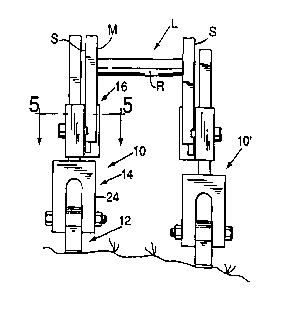Une partie des informations de ce site Web a été fournie par des sources externes. Le gouvernement du Canada n'assume aucune responsabilité concernant la précision, l'actualité ou la fiabilité des informations fournies par les sources externes. Les utilisateurs qui désirent employer cette information devraient consulter directement la source des informations. Le contenu fourni par les sources externes n'est pas assujetti aux exigences sur les langues officielles, la protection des renseignements personnels et l'accessibilité.
L'apparition de différences dans le texte et l'image des Revendications et de l'Abrégé dépend du moment auquel le document est publié. Les textes des Revendications et de l'Abrégé sont affichés :
| (12) Demande de brevet: | (11) CA 2280036 |
|---|---|
| (54) Titre français: | STABILISATEUR POUR ECHELLE |
| (54) Titre anglais: | LADDER STABILIZING DEVICE |
| Statut: | Réputée abandonnée et au-delà du délai pour le rétablissement - en attente de la réponse à l’avis de communication rejetée |
| (51) Classification internationale des brevets (CIB): |
|
|---|---|
| (72) Inventeurs : |
|
| (73) Titulaires : |
|
| (71) Demandeurs : |
|
| (74) Agent: | NORTON ROSE FULBRIGHT CANADA LLP/S.E.N.C.R.L., S.R.L. |
| (74) Co-agent: | |
| (45) Délivré: | |
| (86) Date de dépôt PCT: | 1996-02-13 |
| (87) Mise à la disponibilité du public: | 1997-08-21 |
| Licence disponible: | S.O. |
| Cédé au domaine public: | S.O. |
| (25) Langue des documents déposés: | Anglais |
| Traité de coopération en matière de brevets (PCT): | Oui |
|---|---|
| (86) Numéro de la demande PCT: | PCT/US1996/002085 |
| (87) Numéro de publication internationale PCT: | US1996002085 |
| (85) Entrée nationale: | 1999-08-06 |
| (30) Données de priorité de la demande: | S.O. |
|---|
L'invention porte sur un stabilisateur pour échelle de fixant à l'extrémité inférieure d'un montant de l'échelle et réglable par incréments pour s'adapter aux irrégularités de la surface sur laquelle repose l'échelle. Le dispositif présente une embase comportant des étais avant et arrière espacés conférant une bonne assise à l'échelle. L'embase peut pivoter entre sa position de soutien de l'échelle et une position de rangement.
A ladder stabilizing device (10) is attached to the lower end of a ladder rail
(S). The device (10) is incrementally adjustable to compensate for
irregularities in a ladder supporting surface and has a support base (12)
includes spaced apart front and rear legs (18, 20) to provide sound footing
for the ladder (L). The support base (12) is pivotal between a ladder (L)
supporting position and a storage position.
Note : Les revendications sont présentées dans la langue officielle dans laquelle elles ont été soumises.
Note : Les descriptions sont présentées dans la langue officielle dans laquelle elles ont été soumises.

2024-08-01 : Dans le cadre de la transition vers les Brevets de nouvelle génération (BNG), la base de données sur les brevets canadiens (BDBC) contient désormais un Historique d'événement plus détaillé, qui reproduit le Journal des événements de notre nouvelle solution interne.
Veuillez noter que les événements débutant par « Inactive : » se réfèrent à des événements qui ne sont plus utilisés dans notre nouvelle solution interne.
Pour une meilleure compréhension de l'état de la demande ou brevet qui figure sur cette page, la rubrique Mise en garde , et les descriptions de Brevet , Historique d'événement , Taxes périodiques et Historique des paiements devraient être consultées.
| Description | Date |
|---|---|
| Inactive : CIB de MCD | 2006-03-12 |
| Demande non rétablie avant l'échéance | 2004-02-13 |
| Inactive : Morte - RE jamais faite | 2004-02-13 |
| Réputée abandonnée - omission de répondre à un avis sur les taxes pour le maintien en état | 2004-02-13 |
| Inactive : Abandon.-RE+surtaxe impayées-Corr envoyée | 2003-02-13 |
| Inactive : Grandeur de l'entité changée | 2003-01-31 |
| Inactive : Page couverture publiée | 1999-10-14 |
| Inactive : CIB en 1re position | 1999-10-12 |
| Inactive : Supprimer l'abandon | 1999-09-16 |
| Inactive : Notice - Entrée phase nat. - Pas de RE | 1999-09-14 |
| Demande reçue - PCT | 1999-09-11 |
| Réputée abandonnée - omission de répondre à un avis sur les taxes pour le maintien en état | 1999-02-15 |
| Demande publiée (accessible au public) | 1997-08-21 |
| Date d'abandonnement | Raison | Date de rétablissement |
|---|---|---|
| 2004-02-13 | ||
| 1999-02-15 |
Le dernier paiement a été reçu le 2003-01-23
Avis : Si le paiement en totalité n'a pas été reçu au plus tard à la date indiquée, une taxe supplémentaire peut être imposée, soit une des taxes suivantes :
Les taxes sur les brevets sont ajustées au 1er janvier de chaque année. Les montants ci-dessus sont les montants actuels s'ils sont reçus au plus tard le 31 décembre de l'année en cours.
Veuillez vous référer à la page web des
taxes sur les brevets
de l'OPIC pour voir tous les montants actuels des taxes.
| Type de taxes | Anniversaire | Échéance | Date payée |
|---|---|---|---|
| Rétablissement (phase nationale) | 1999-08-06 | ||
| Taxe nationale de base - petite | 1999-08-06 | ||
| TM (demande, 2e anniv.) - petite | 02 | 1998-02-13 | 1999-08-06 |
| TM (demande, 3e anniv.) - petite | 03 | 1999-02-15 | 1999-08-06 |
| TM (demande, 4e anniv.) - petite | 04 | 2000-02-14 | 2000-01-14 |
| TM (demande, 5e anniv.) - petite | 05 | 2001-02-13 | 2001-01-25 |
| TM (demande, 6e anniv.) - petite | 06 | 2002-02-13 | 2002-01-24 |
| TM (demande, 7e anniv.) - générale | 07 | 2003-02-13 | 2003-01-23 |
Les titulaires actuels et antérieures au dossier sont affichés en ordre alphabétique.
| Titulaires actuels au dossier |
|---|
| WILLIAM MOSELSKY |
| Titulaires antérieures au dossier |
|---|
| S.O. |